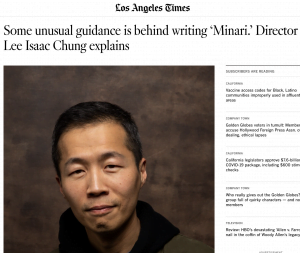This week in The Los Angeles Times, you can read an article by Lee Isaac Chung, the director of the semi-autobiographical film Minari, about how the vision for the film came to him. Normally, something like this would appear as an interview, but here Chung has taken the time to compose an intimate testimony of a strange and “mystical” experience.

This isn’t the first time he has offered an essay of his own about his experiences.
Soon after Chung’s extraordinary debut Munyurangabo, which he made in collaboration with his longtime filmmaking partner Sam Anderson, he offered an essay about his journey into filmmaking to me and my co-editor at a short-lived journal for film enthusiasts called Filmwell. It gives us several glimpses of Chung’s curiosity and his conscience. We encounter his grandmother, the woman who inspired the character of Soonja in Minari. We learn a bit about film history. And we learn about a world of filmmaking that most of us have never read about before.
(You can find the archives of Filmwell at The Other Journal, and you can see the original publication here.)

Retrospectives
an essay by Isaac Chung
1.
My grandmother didn’t finish elementary school and lived a daily resignation to poverty and struggle for most of her life. Her illiteracy caused both shame and sympathy for my father, notably because he is a gifted writer. Yet, he remembers the way others revered her in the village because she told stories. They were recollections, simple stories sprung from a memory that gathered passing moments others had disregarded, occurrences with meanings she alone discerned.
My father told me this when I was ten — it is a small footnote in our family history but one that I revisit often. How can storytelling bring a humble woman the respect of an entire village? Then, I remember that even scripture is an epic narrative.
2.
In the 1880s, a great argument arose between the Lumière brothers and Thomas Edison about their new invention, the motion picture camera. To this day, no one is sure who invented it first.
Edison’s Kinetoscope featured vaudeville performers and fighting animals while the Lumière’s captured everyday life; both foreshadowed a division between the US and France that remains today — cinema as spectacle and cinema as art.
One could argue that cinema has become the most powerful form of storytelling in the world. Anti-Western sentiment, especially the type directed against Hollywood, does not deny this contention; it disagrees with the stories.
3.
In the 1990s, Kenneth Nnebue, a businessman in Nigeria, imported blank videotapes from Asia to sell in the local marketplace. Finding that he had ordered too many, he decided to make a small movie to include on the tapes as an extra incentive to buy. 750,000 sold copies of the film and thousands of imitations later, “Nollywood” is now the third largest film industry in the world behind the US and India. It remains the second largest provider of jobs in Nigeria, after subsistence farming.
They are crudely and quickly shot with over two thousand new titles a year to keep up with local demand for African films. Western audiences might cringe at the exaggerated acting and stories of HIV and witchcraft, but each of the noisy videos proclaims, “we wish to speak too.”
4.
The art of memory collects disparate details from the past and reshapes them into a harmonic whole. It is a dying art in much of the world where society has less of a demand for remembrance and a greater emphasis on daily production and consumption. So great is the divide between everyday existence and active reflection that modern storytelling — the cinema — is no longer interested in life. There is a common saying, “I go to the movies because I wish to escape.” Meanwhile, the culture of escape spreads from the West to the rest of the world like industrial haze.
It reaches Rwanda, where, after the tragic Rwandan genocide of 1994, several personal accounts recall that genocidaires liked to mimic Rambo films when slaughtering others, a chilling detail for moviegoers.
In a great irony, Western penitence has invaded Rwanda several times to recreate the genocide for film crews that resemble, at first glance, a military occupation. Its height is reached in Hotel Rwanda, in which American actors fake African accents in a story that many Rwandans dismiss as overly exaggerated to sell tickets. Its target audience is the West, and as the spectacle — with its prestige, Oscars, and box office data — passes from our minds to obscurity, Rwanda is left with few resources to share its own recollection of the tragedy, to engage in the art of memory.
(My work in Rwanda is:
– A quiet endeavor — to train and equip a group of fifteen Rwandan filmmakers who want to share their stories and transform their nation and perhaps the world.
– An act of resistance — against a pervasive and spreading fog that allows only the powerful to have a voice.
– A remembrance.)